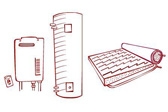
These days, hot running water’s an indispensible luxury (some would say a necessity). Find out more about how water is heated and delivered to where it’s needed in your home.

Hot water systems come in a range of shapes and sizes to suit all kinds of needs, and can heat water using a variety of fuels, including natural gas, LPG, solar energy, electricity, geothermal energy and even hydrogen power. Hot water systems are generally split into one of two different types: storage tank units, and continuous flow systems (also called instantaneous or tankless systems).
Storage tank hot water systems
These systems work by heating the water (typically using solar energy, electricity or natural gas) and then storing it in an insulated tank. Gas is generally preferred over electricity for these kinds of systems, mainly because electricity is vastly more inefficient and contributes much more in terms of greenhouse emissions. Tank storage systems that heat water using solar collectors on roofs are also popular, although in most parts of Australia these will require a gas or electric booster too, to ensure there’s adequate hot water even when the sun refuses to shine.
Continuous flow hot water systems
Continuous flow hot water systems work by rapidly heating water as and when it’s needed. These systems are ideal for smaller households or as a supplemental system in larger houses. Although electric varieties are available, most continuous flow hot water units run on natural gas (or LPG, where that’s not available).
How your installation works
Hot water systems (or any other plumbing sytems, for that matter) should never be installed or worked on by anyone other than a licensed plumber. The first thing the plumber will do is plan the path of the hot water pipe throughout the house. This begins at the selected water heater location, with accurate measurements taken from the heater to each relevant outlet.
In many cases, the first length of pipe coming out of the hot water unit will be copper or steel, even if plastic piping is used elsewhere. Metal piping has a far greater resistance to heat than plastic does, and this helps to ensure that pipes aren’t damaged by the heat of the water.
All taps and outlets are then connected to your hot water supply. Once connected, the hot water line is pressurised by turning on the supply to the hot water unit. Once this is done, all fittings and joints are checked for leaks.
Keeping the water hot
To reduce the amount of piping required, and to ensure that there’s as little distance as possible between the water heater and taps, houses are generally designed so that rooms where hot water will be required (e.g. bathroom, laundry, kitchen) are clumped together on the house plan. In most cases, the water heater will be installed as close to these areas as possible, either on an outside wall or in a cupboard. This reduces what’s known as the ‘dead leg’ water wastage – the water that’s cleared from the pipes as you wait for the hot water from your water heater to arrive at the tap.
It’s worth noting that this dead leg water can add up to a significant amount – in some cases up to 5 litres at a time. Recent regulations have been written to reduce the amount of wasted water by limiting the distance and diameter of hot water piping, by recommending a recirculation system to recycle the dead leg water, and by regulating the rate of flow in hot water systems.
Hot water pipes are normally fittted with what’s known as ‘lagging’ too – a type of insulation for pipes. Lagging helps to reduce the amount of heat that’s lost through the pipes themselves, ensuring that as little heat as possible is wasted.
To learn more about hot water systems, visit hotwater.build.com.au.





